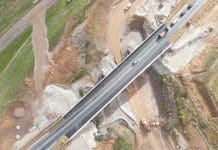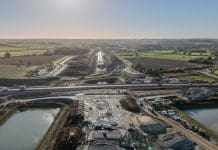In an interview with Jon Kerbey, Director of BIM at HS2 he explains to Editor Lisa Carnwell, how BIM will be utilised on the UK’s first high speed rail endeavour
HS2 has not been met with universal glee from everyone in the UK and still has its critics with many believing there is no real business case for it. Whatever your stance, the now Conservative-led government have always maintained its importance for the UK economy and will strive to ensure its implementation. They believe that HS2 is all about the future of building and strengthening the economy and the importance of recognising the growth of cities and the need to link them efficiently.
The first phase of HS2 between London and Birmingham was voted for in the House of Commons last year with a staggering majority of 452 to 41. The Hybrid Bill is now going through the parliamentary scrutiny process at Select Committee stage, where they are examining the route with a fine tooth-comb. It is hoped that the Bill will receive Royal Assent sometime in 2016.
Construction of the first stage will begin in 2017 with enabling works, utility diversions and demolition. Major tunnelling and civil engineering work will start in 2018. Once complete, the new line will connect with the existing network north of Birmingham to allow services to travel onward to places like Liverpool, North Wales, Stoke-on-Trent, Glasgow and Edinburgh.
It is estimated that around 26,000 people will work on delivering HS2 with more than £10bn of civil engineering contracts due out for tender later this year. A project of this scale demands an approach that can handle the complexities of large-scale infrastructure – BIM of course was the natural choice for delivery. Jon Kerbey outlines the fact that: “Nothing as yet has been built, all our value lies in our data about the railway. Using BIM as the methodology and the mechanism for capturing all that data and turning it into useful information and knowledge is the backbone of the project’s success”.
Standards
Using the standards involved in working to BIM Level 2 ensures that HS2 can use them in contracts to specify to the supply chain. Kerbey explains:
“We have examined some of the standards to see how we can implement them most effectively and efficiently throughout all the supply chain. Because some standards are more accepted than others in terms of the supply chain capability level, we ran a supply chain upskilling study last year which was published back in October available here.
“It clearly showed that Tier 1 companies are confident in meeting the standards as they are already doing BIM, or are well on the way to doing it. However, the study showed that if HS2 doesn’t intervene with Tier 2 organisations and below, there may be some issues with them meeting the requirements. HS2 are working on that at the moment – how we can best engage with them, and what that engagement looks like.” Education and skills
Being engaged with the supply chain also means that HS2 are quite visible in conferences and events – explaining what they are doing, what they want to do, and what their vision is. As part of the up-skilling study, they are starting to implement some of the recommendations resulting from it. One is to develop an up-skilling portal – as described by Kerbey as like “a web-based environment for interested parties to visit and learn about guidance, what we are doing, and what processes we will have, and what it means to meet the requirements of BIM in HS2.” The portal is due to be released in the next couple of months.
“It will be open to everyone and we will continue to develop it as our requirements become clearer and we get closer to procurement and contract awards,” Kerbey says.
“The content will be continually developed to make sure it is useful to everyone – not just our supply chain. We want it to be as helpful as possible to the wider construction industry, picking up the baton from Crossrail in terms of what they have done for industry, by learning their lessons and hopefully moving industry on.
“It is part of our duty as a major infrastructure project to help, but without catalysts like HS2 and Crossrail, it can be difficult to get momentum. The government has done a great job in promoting awareness of Level 2 and – at the end of the day – there’s nothing like the lure of big contracts to motivate firms.”
It is widely recognised that the UK has a shortage of the required construction skills, especially for HS2, or indeed any large rail project. At the moment, we have many capable of basic construction skills up to level 2, but HS2 need at least 50% of the workforce to be above that level. They are addressing this shortage through assisting the Department for Business, Innovation and Skills to establish the new National College for High Speed Rail, which will help to develop the next level of skills needed by the time of peak construction. HS2 will be able to act as a catalyst for the industry – giving it a shove on BIM, but also a shove on basic level skills too.
It is hoped that by initiatives such as the new college, the image of engineering can be changed. No longer should the sector be seen as just manual work – with the advent of BIM, there are whole new careers available with technology at the heart. Only 1 in 7 engineering graduates are women. There is no real reason for this low figure – it just needs a little encouragement for them to take up the new roles. Industry is changing quickly, but people’s perceptions are lagging behind.
Challenges
Any project of this scale will create many challenges, but foremost on Kerbey’s ‘worry list’ at the moment is that of procurement. He discussed the issue of specification stating it was vital that:
“We are specifying in enough detail for our supply chain – making sure we have the right information and BIM standards within the contracts, and making sure we have the right incentives in place to ensure we can deliver on our requirements”.
He went on to say that:
“It’s hard to specify really early in a project – which is what BIM requires for it to be successful – so you need an intelligent client. It’s difficult to maintain the balance between under specifying so that you have complete flexibility in the supply chain, and over specifying so you almost stifle innovation. There aren’t many user cases to go against, but working closely with Crossrail has enabled us to understand how they would do things differently this time”.
The software
Kerbey outlined that it was important to remain agnostic in their approach to the software used in the BIM process. They have listened to what the supply chain want and are trying to take technology out of the equation by concentrating on the information required. He explains:
“The reason we want to remain agnostic about software use is because if we were to dictate a software platform or design package that all of our supply chain had to use, it might mean that it may not be relevant to all of the disciplines that require different software packages.
“Also, we would be putting a massive reliance on some of our smaller suppliers to upskill in a package they may never use again on another project. This would be a big investment for them, not just from a training perspective, but also a software licensing perspective. The suppliers are comfortable with the packages they already use and they know how to get the best out of them in the most efficient way. We want to take advantage of that. If we as the client can accept data from any software package, then that will help the supply chain.”
This software agnostic approach should also enable a simple approach to COBie detailing. The ability to use the data schema as the data exchange protocol doesn’t change the approach as to whether HS2 used a single, or a multi-vendor route. Using a standard format to validate and to check asset information against it is vital. As Kerbey explains:
“If we can standardise data throughout the entire supply chain, then we’ve got a relatively easy job of joining everything together. However, the amount of data is really a different matter. This is one of the areas that we are testing at the moment – just to ensure that it is effective and efficient and we can do something with it.”
A successful BIM project
So what does a successful BIM project look like? What first steps are the most important? For Kerbey, the key is standardisation. This was the first aspect made clear in the project – making sure that everyone had standards to work to that achieved standardised data deliveries, and that there was a standard common data environment that people actually worked in. This for Kerbey ensured they could improve the validation and assurance processes and streamline some of the delivery, and therefore, examine what efficiencies could be achieved.
One of the biggest benefits of BIM is that by working in a virtual world, the project can be tested and certainties realised very early on. As Kerbey described:
“When you do finally get onsite, you know what’s going to happen, when it’s going to happen, what will go where, and where people will be – the whole process is about mitigating risk. We are doing this earlier than anyone has before which has meant a change of working. BIM is very much about a cultural change and about people making decisions early on in the project. It has certainly presented more opportunities than it has frustrations, and provided a big learning curve for both the client and the supply chain.”
HS2 is reaping the lessons learned from Crossrail, which is perhaps Europe’s largest construction project to date. In an interview in an earlier edition of PBC Today, their Head of Technical Information Malcolm Taylor, said that the Crossrail project would be “exploiting, exploring and developing technologies that will be copied and built upon in future projects”. He wasn’t wrong. Kerbey acknowledged that one of the lessons learned means that:
“We actually understand a lot about our assets already. Even though we haven’t built anything, we have virtual assets and we know where they are down to a certain level of detail. We are capturing information about them now and that will continue to mature as we go through construction, moving to as-built asset information. The big benefit is having a really efficient hand-over of information from HS2 construction, to operations and maintenance. By working in a data driven environment now, and to a standardised approach, we will be able to hand over data easily.”
Meeting the 2016 deadline
The question of whether industry will meet the 2016 deadline is usually met with a similar response to that of Kerbey, who said he hoped they would. It seems pretty clear that those who are already engaging in BIM are seeing the benefits and will continue to develop their processes, but there is still some work to do. The HS2 supply chain BIM upskilling study showed that with certain tiers of the supply chain, some progress is still required and for Kerbey, he believes that:
“We need to make BIM fit for purpose, particularly for the lower levels in the supply chain – making sure they understand what they have to do, and that BIM is not a big unwieldy beast that maybe Tier 1 organisations have to cope with. It’s important to make it relevant to the people and organisations that are doing it.” ■
. . . . . . . . . . . . . . . . . . . . . . . . . . . . . . . . . . . . . . . . . . . . . . .
Jon Kerbey
Director of BIM
HS2 Ltd
www.gov.uk/government/organisations/high-speedtwo-limited



![[VIDEO] HS2 completes 4,600-tonne viaduct slide across M6 The HS2 team completed a 17-hour long operation sliding the viaduct structure across the M6 without closing the motorway](https://www.pbctoday.co.uk/news/wp-content/uploads/2025/12/M6-South-viaduct-slide-taking-place-across-a-live-motorway-December-2025-218x150.jpg)







![[VIDEO] HS2 celebrates final boring tunnel breakthrough The 125-metre-long tunnel boring machine was launched in March 2024 and arrived at Washwood Heath yesterday morning (13 October)](https://www.pbctoday.co.uk/news/wp-content/uploads/2025/10/HS2-staff-engineers-and-tunnellers-gather-in-front-of-the-Bromford-tunnels-after-the-breakthrough-of-Elizabeth-Oct-2025-218x150.jpg)

![[VIDEO] HS2 M6 viaduct slide completed early The HS2 M6 Viaduct on its sliding journey](https://www.pbctoday.co.uk/news/wp-content/uploads/2025/09/M6-viaduct-East-Deck-in-place-over-the-motorway-September-2025-218x150.jpg)
